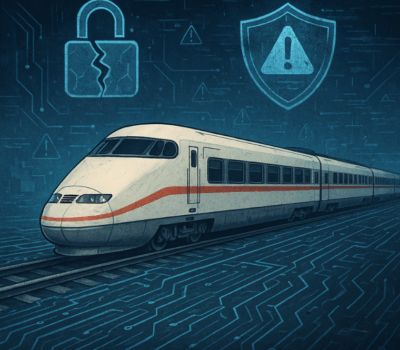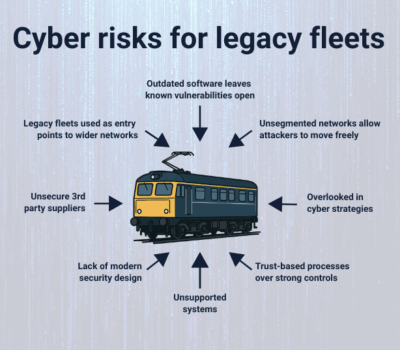A
Automatic Train Control (ATC): A system that automates the train operations, ensuring trains run at safe speeds and maintain safe distances from each other.
Axle Counter: A device used to detect the presence of a train on a track by counting the axles of the train as it passes over a set point.
Artificial Intelligence (AI): AI is using computer systems to perform tasks that usually require human intelligence.
Automated Vehicle Inspection System (AVIS): An Automated Vehicle Inspection System (AVIS) is a high-tech system that checks the condition of vehicles using sensors, cameras, and other smart tools. It performs quick, accurate inspections to spot issues like wear and tear or maintenance needs, all without needing a manual check. It’s a fast and reliable way to ensure vehicles are safe and road-ready!
Automated Vehicle Inspection System (AVIS) Data Review: AVIS Data Review is the process of analysing data collected by an Automated Vehicle Inspection System. These systems use advanced technology to inspect vehicles quickly and accurately, capturing detailed information about their condition. The data review helps identify any issues or maintenance needs, ensuring vehicles are safe and up to standard without the need for manual checks. It’s a fast, efficient way to keep vehicles in top shape!
B
Ballast: The crushed stones or gravel laid underneath and around railway tracks to provide stability and drainage.
Block Section: A segment of railway track with defined entry and exit points, typically controlled by signals to ensure only one train occupies the section at a time for safety.
Bogies: The framework carrying the wheels of a railway vehicle, providing stability and smooth movement over the tracks. Also known as trucks in some regions.
C
Coupler: A device used for connecting rolling stock in a train. Different types of couplers are used in various parts of the world and on different types of trains.
Catenary: The overhead wire system that supplies electric power to trains. It consists of a contact wire, supporting wires, and structures to hold them up.
D
Derail: An incident where a train leaves its tracks, often leading to accidents and requiring significant safety measures and protocols to prevent.
Diesel Multiple Unit (DMU): A type of train powered by diesel engines located in each carriage, allowing for flexible and efficient operation without the need for a locomotive.
E
Electrification: The process of powering trains via overhead wires or electrified rails, which can provide cleaner and more efficient energy compared to diesel engines.
ETCS (European Train Control System): A standardised train control system used throughout Europe to ensure interoperability and enhance safety on international railways.
F
Freight Train: A train used for transporting goods and materials rather than passengers. These trains play a crucial role in supply chains and logistics.
Feeder Line: A secondary railway line that connects smaller stations or industrial facilities to the main railway network.
G
Gasification: This process turns waste into gas by heating it to very high temperatures (usually over 700°C) in a low-oxygen environment. Because there isn’t much oxygen, the waste doesn’t burn but instead breaks down into gases, mostly a mixture called syngas (synthetic gas). This gas can be used as fuel to produce electricity or heat. It’s a cleaner way to deal with waste compared to burning it (incineration).
Gauge: The distance between the inner sides of the two parallel rails that make up a railway track. Different gauges are used around the world, with standard gauge being the most common.
Geographic Information Systems (GIS): GIS sound mapping refers to the use of Geographic Information Systems (GIS) to visualise and analyse sound-related data across geographic locations. It combines spatial data with acoustic information to create maps that represent soundscapes, noise pollution, or other auditory phenomena in different areas.
Grounding: The practice of safely discharging electrical currents to the ground to prevent electrical hazards in the railway system.
H
Headway: The time interval between two trains travelling in the same direction on the same track. Shorter headways allow for more frequent train services.
High-Speed Rail (HSR): Rail transport that operates significantly faster than traditional rail traffic, using specialised tracks and advanced technology to achieve speeds typically over 250 km/h (155 mph).
I
Interlocking: A system used to prevent conflicting movements through an arrangement of tracks such as at a junction or crossing, ensuring that only safe routes are set for trains.
Intermodal: Transportation involving more than one form of carrier, such as rail and lorry, to move goods efficiently across different modes of transport.
Internet of Things (IoT): IoT connects devices and allows systems to share real-time data which in turn allows for smarter and quicker decision-making. For example, Passenger Information Systems (PIS) with real-time capability can ensure that the latest information is displayed.
J
Junction: A point where two or more rail lines meet or cross, allowing for trains to switch from one track to another.
K
Kilometre Post (KP): Markers placed alongside the track to indicate the distance from a specific starting point, used for navigation and maintenance purposes.
L
Light Rail: A form of urban passenger rail transit characterised by lower capacity and speed compared to heavy rail, often running on city streets as well as dedicated tracks.
Locomotive: The engine vehicle that provides the motive power for a train, typically located at the front but can also be positioned in the middle or at the rear.
M
Maintenance of Way (MOW): The upkeep and repair of the railway track and infrastructure to ensure safe and efficient operation.
Marshalling Yard: A railway yard used for assembling freight trains by sorting and organising railcars into the correct order.
Maintenance Design Justification File (MDJF): A document used in the rail industry to justify and outline the design and maintenance decisions for railway assets, particularly regarding safety, reliability and performance. The MDJF serves as a record that ensures maintenance activities and designs are well-documented and aligned with industry standards, regulations and the operational requirements of the railway system.
N
Night-time quiet period (NTQP): A night-time quiet period for rail is a set time, usually at night, when train operations are limited or noise is reduced to avoid disturbing nearby residents. It typically involves minimising noise from freight trains, track maintenance, and train horns during hours like 11:00 PM to 6:00 AM.
Noise dosimeter: A noise dosimeter is a device used to measure a person’s exposure to sound levels over time, typically in workplaces with high noise levels, such as construction sites, factories and rail environments. It helps assess whether noise exposure exceeds safe limits set by regulations, aiding in hearing protection and compliance with occupational safety standards.
Non-Revenue Service: Train operations that do not generate income from passengers or freight, such as maintenance runs or positioning moves.
O
Overhead Line Equipment (OLE): The assembly of wires and support structures that deliver electrical power to trains from above.
P
Passenger Information System (PIS): Technology used to provide real-time information to passengers, including train schedules, delays, and announcements.
Points (Switches): Movable sections of track that guide trains from one track to another at a junction.
Pyrolysis: Waste is heated to high temperatures, typically between 400°C and 800°C. This process breaks the waste down into useful products like oil, gas, and charcoal-like materials. Pyrolysis is often used for things like plastic waste, tires, or biomass (organic materials).
Q
Quiet Zone: Areas where train horns are not routinely sounded, usually at designated crossings, to reduce noise pollution.
R
Right-of-Way (ROW): The legal right to build and operate a railway line on a particular route. It also refers to the land on which the railway is built.
Rolling Stock: All the vehicles that move on a railway, including locomotives, passenger cars, and freight wagons.
S
Signalling System: A system of signals and controls used to direct railway traffic and ensure safety. This can be manual, automated, or a combination of both.
Sleeper (Tie): A rectangular support for the rails in railway tracks, traditionally made of wood but also concrete or steel, that maintains the correct gauge.
T
Track Circuit: An electrical system used to detect the presence of a train on a section of track by completing or breaking an electrical circuit.
Traction Power: The power supply used to move trains, which can be provided by electric or diesel engines.
Train Spares, Services and Supply Agreement (TSSSA): A TSSSA is a contract that ensures a train operator gets the necessary spare parts, maintenance services, and support to keep their trains running smoothly. It covers everything from supplying components to providing technical assistance, helping to maintain reliable train operations and minimise downtime. It’s like a one-stop shop for keeping trains in top condition!
Train Service Agreement (TSA): A TSA is a contract between a train operator and a service provider that outlines the terms for maintaining and operating trains. It covers things like scheduled services, maintenance, performance standards, and responsibilities, ensuring smooth operation and clear expectations on both sides. In short, it helps keep the trains running on time and in good shape!
U
Underframe: The structural framework underneath a rail vehicle that supports the body and equipment, distributing the load to the wheels.
Uncoupling: The process of disconnecting railcars from each other, typically done in marshalling yards or at specific points in a train’s journey.
V
Viaduct: A long elevated railway bridge consisting of a series of short spans supported by arches or piers, used to traverse valleys or other obstacles.
W
Waste Management Hierarchy: is a system that ranks waste management strategies by their environmental impact, typically illustrated as a pyramid. At the top is prevention, which prioritises avoiding waste generation altogether. The next step is to reuse materials or products without significant processing. When reuse is not possible, recycling should be the preferred option, then energy recovery processes, such as incineration, and finally the least preferred option – disposal.
Waybill: A document issued by a carrier giving details and instructions relating to the shipment of a consignment of goods.
Wheelset: A set of wheels mounted on an axle, an essential component of the rolling stock that interacts with the rails.
Y
Yard: A complex of tracks and other infrastructure where trains are assembled, disassembled, and stored.






